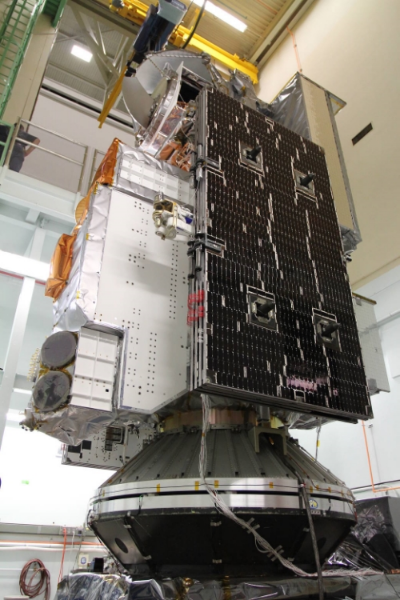GPM completes satellite vibration tests on a shaker. Image credit: www.NASA.gov. This post is not endorsed by NASA.
Satellite Vibration Testing
As a satellite flies quietly in outer space, it must be able to function under extreme operating conditions. It works in almost a vacuum, and faces high electromagnetic radiation and dramatic temperature changes. During launch, satellites undergo extremely high levels of vibration and acoustic noise which can severely impair or damage their components. Because of extreme launch forces and tough environmental strains, it is crucial to thoroughly test the whole satellite, including all subsystems, before sending these expensive and delicate objects into space.
Extensive product qualification tests and stress screening tests are carried out to ensure that satellites will survive the launch, deployment, and operation stages of its lifecycle. For space research organizations, safe tests of the satellites are critical to capture vibration and noise data. Satellite vibration tests are the most carefully arranged and monitored tests, because of their high cost and delicate nature.
In general, data acquisition and analysis systems with hundreds of channels are used to simultaneously acquire the vibration data from nearly all locations of the satellite. The vibration test systems consists of electro-dynamic shakers. The size of the shakers depend on the size and payload of the satellite under test. Typically, the satellite is mounted onto a vertical head expander and horizontal slip table.
Swept Sine is one critical test for satellite qualification. Because all tests are run on an actual satellite, prevention of over-testing is crucial, as is the ability to apply limiting channels. With limiting channels, maximum allowable vibration levels are assigned to the limit channels at specific locations of satellite as well as its sub-systems. Once these channel levels reach the predefined limits, the drive signals will be “notched” to reduce the test level and make sure the limits are not exceeded at these limiting locations.
In cases where a vibration controller system does not come with a high enough channel count required for a specific test or an independent analysis system is required, a specialized dynamic signal analyzer can be used. The dynamic signal analyzer will run so-called Sine reduction software which allows simultaneous measurement of hundreds of channels of Sine data, and can be used to do additional monitoring. The synchronization between the Sine Controller and Sine Reduction Analyzer is the Constant Output Level Adaptor (COLA) signal, which carries the sweeping sine frequency information and with a constant voltage level.
Recording of data is also a critical component of satellite testing. The controllers and analyzers offer the option for simultaneous recording of time history data from all channels during vibration testing. All vibration data is recorded for record and post analysis.
Crystal Instruments supplies both high channel count vibration controllers and large channel count dynamic signal analyzers. With the vibration testing system supplied by Sentek Dynamics, a turnkey solution for satellite testing can be achieved for both commercial and military purposes.
For more information about satellite vibration testing, contact sales@go-ci.com.

